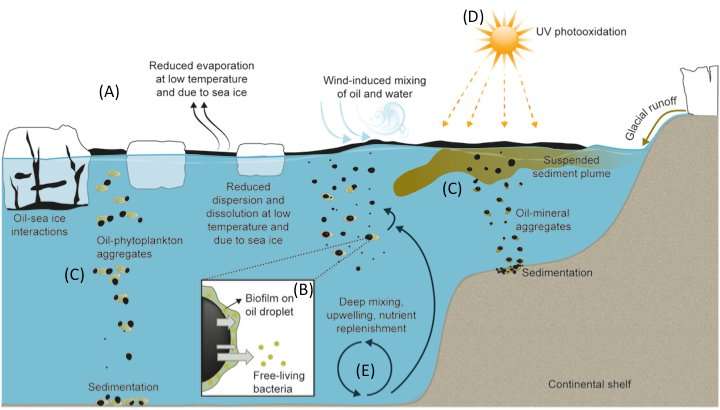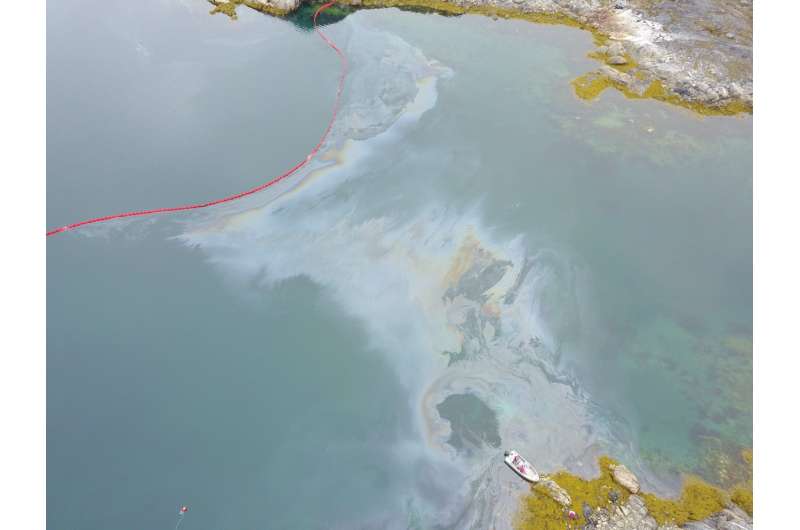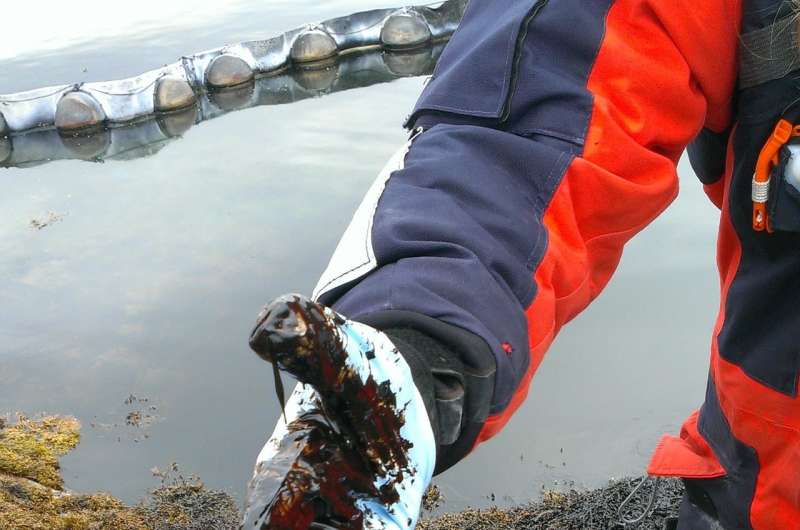Schematic diagram of Arctic-specific conditions that affect microbial degradation of oil spills: A) Sea ice and icebergs hamper wind/wave-induced mixing in the upper water column and cause a thicker oil slick, which, in combination with low temperature, reduces evaporation, dispersion and dissolution. All these effect result in larger oil droplets, which microbes cannot degrade.B) Most oil compounds are not soluble in water. Therefore, the bacteria form a biofilm on the oil droplets in order to be able to consume the oil compounds. A small fraction of the oil compounds is water-soluble and thus consumed by both biofilm and free-living bacteria.C) Oil-mineral and oil-phytoplankton aggregates, which may enhance oil sedimentation ('dirty blizzards'), are formed upon interaction with sediment plumes from glaciers and phytoplankton blooms, respectively. D) Photooxidation by ultraviolet radiation from sunlight can be important, espectially during summer. Ultraviolet light helps degrading oil molecules, but at the same time, the oil toxicity towards marine organisms may increase.E) Deep mixing of the water column and upwelling cause nutrient replenishment. Oceanographical conditions may thus be important to provide fresh nutrients for oil-eating microbes. Credit: Leendert Vergeynst
New economic developments in the Arctic, such as trans-Arctic shipping and oil exploitation, will bring along unprecedented risks of marine oil spills. The world is therefore calling for a thorough understanding of the resilience and "self-cleaning" capacity of Arctic ecosystems to recover from oil spills.
Although numerous efforts are put into cleaning up large oil spills, only 15 to 25 percent of the oil can be effectively removed by mechanical methods. This was the case in major oil disasters such as the Exxon Valdez spill in Prince William Sound, Alaska, and the Deepwater Horizon in the Gulf of Mexico. Future spill will be no different. Oil-eating microbes played the major role in degrading the oil and reducing the impact of the spilled oil during these past oil disasters.
"We are now presenting a first assessment of the microbial degradation potential in seawaters off Greenland," says postdoc Leendert Vergeynst, Arctic Research Centre at Aarhus University.
The research group has identified six factors challenging the microbes in Arctic seas.
Low temperatures, sea ice and few nutrients
Low temperatures change the chemical properties of spilled oil and slow down biodegradation. For example, cold oil is more viscous, which hampers oil dispersion. The efficiency of microbial degradation is decreased when oil is not dispersed in small droplets.
We need a thorough understanding of the resilience and "self-cleaning" capacity of Arctic ecosystems to recover from oil spills. Credit: Janne Fritt-Rasmussen
Waves also plays an important role in breaking the oil into droplets. However, where there is sea ice, there are fewer waves.
The Arctic is generally an environment with very low amounts of nutrients such as nitrogen and phosphorus. These nutrients are not present in the oil and oil-eating bacteria therefor need to find them in the water. Few nutrients result in reduced activity of the oil-eating bacteria.
Particle formation, sunlight and adaptation
Massive phytoplankton (algae) blooms and suspended mineral particles released by glaciers occur during the Arctic spring and summer. The concentrations of particles from glacier outlets and algae blooms in Arctic waters can be magnitudes higher than in the Gulf of Mexico, where phytoplankton, particles and oil droplets stick together and sink to the seafloor, which formed a "dirty blizzard" during the Deepwater Horizon oil spills in 2010. Microbial degradation of oil on the seafloor is much slower than in the water column.
Past oil disasters have shown that only 15 to 25 percent of the oil can be effectively removed from the marine environments. Credit: Janne Fritt-Rasmussen
The 24-hour sunlight during the Arctic summer may help the microbes to break up oil molecules into smaller pieces. However, it may also make the oil compounds more toxic for aquatic organisms. More study is required to properly understand the effect of sunlight on oil spills in Arctic ecosystems.
Regular small oil spills in other marine waters have adapted ('learned') microbes to eat oil molecules. However, the Arctic is still a very pristine environment. The researchers are therefore currently investigating if the microbial populations present in the Arctic have adapted to degrading oil compounds.
"We are especially concerned that the most toxic molecules in the oil, such as polycyclic aromatic hydrocarbons, may be the most difficult to degrade" says Leendert Vergeynst.
More information: Leendert Vergeynst et al. Biodegradation of marine oil spills in the Arctic with a Greenland perspective, Science of The Total Environment (2018). DOI: 10.1016/j.scitotenv.2018.01.173
Journal information: Science of the Total Environment
Provided by Aarhus University

























